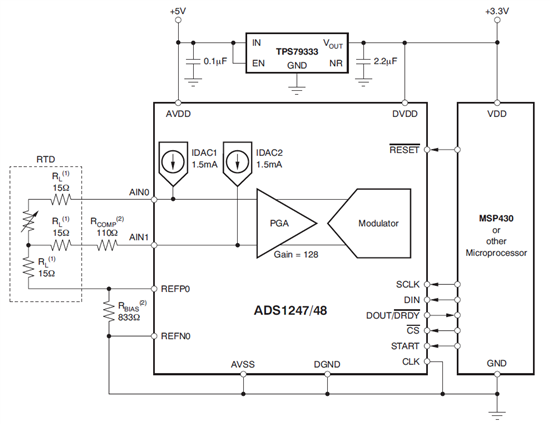PT100 circuitry(ADS1247/48) |
您所在的位置:网站首页 › ads1247心得 › PT100 circuitry(ADS1247/48) |
PT100 circuitry(ADS1247/48)
|
Hello Anand, The ADS1247 is perfectly suited for use with PT100 RTDs. Three-wire or four-wire connections are simply ways of improving the accuracy of a resistance measurement by cancelling the resistance of the wires used to make the measurement. This is an issue because resistance measurements are performed by using wires to force a current through the resistance and measuring the resulting voltage drop. However, the wires themselves also have a resistance (called lead resistance), so the voltage drop that develops across the wires themselves can negatively affect the accuracy of the measurement. Three-wire and four-wire connections correct for this by measuring the voltage drop with additional wires (called sense wires) through which no current flows, so no additional voltage drop occurs. The "Operating Principle" section in the following article does a great job of explaining this concept: Four-wire Sensing. In general, a three-wire RTD connection is sufficient since the voltage drop from the "positive" force wire is the same as the voltage drop from the "negative" force wire or common wire. A bridge circuit was used in the document you linked because the instrumentation amplifier used (INA114) did not have built-in current sources available. The ADS1247 has two built-in, well-matched excitation current sources which can be digitally programmed to certain values (50μA, 100μA, 250μA, etc.) so the additional bridge circuit is not required. If you follow the example of Figure 85 on the ADS1247 data sheet (shown below) you can get excellent performance with a three-wire PT-100 RTD.
Best regards, Ian WilliamsLinear Applications EngineerPrecision Linear and Sensing Products |
【本文地址】
今日新闻 |
推荐新闻 |
